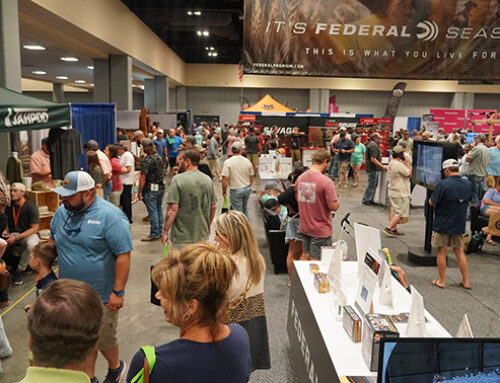Three Waterfowl Species Subject to be Renamed
North American birds that were named after people will be given new monikers

By Paul Wait
The American Ornithological Society plans in 2024 to begin renaming up to 80 bird species, and three waterfowl species—Ross’s goose, Barrow’s goldeneyes, and Steller’s eiders—are likely to be among the birds that are given new names.
AOS, the recognized authority on bird naming in North America, plans to rename all species that are named after people. In a Nov. 1 press release, the AOS announced the changes are being made “in an effort to address past wrongs and engage far more people in the enjoyment, protection, and study of birds.”
Many bird species were named centuries ago to honor explorers and other prominent people, some of whom have ties to slavery and racism.
“There is power in a name, and some English bird names have associations with the past that continue to be exclusionary and harmful today,” said Dr. Colleen Handel, AOS president and research wildlife biologist with the U.S. Geological Survey in Alaska. “We need a much more inclusive and engaging scientific process that focuses attention on the unique features and beauty of the birds themselves.”
AOS will begin the process by forming a committee in 2024 to oversee a pilot project for a first set of birds to be renamed, possibly about 10 species, according to Handel. As of now, the initial birds have not been determined.
Of the three waterfowl species, Ross’s goose is the most likely to change names soonest because the species occurs predominantly in North America, where the AOS has naming jurisdiction. Barrow’s goldeneyes also breed in Iceland, while the population of Steller’s eiders extends well into Russia.
“The AOS will consult with other ornithological organizations for species that occur outside the U.S. and Canada before considering those name changes,” Handel said.
The Ross’s goose (Anser rossii) is named in honor of naturalist and fur trader Bernard Rogan Ross in 1861. According to the Dictionary of Canadian Biography, Ross was a native of Ireland who immigrated in 1843 to Canada to work for the Hudson’s Bay Company, where he ascended to the post of chief trader in 1856. A well-educated man, Ross served as a correspondent for several historical societies and wrote several scientific papers.
“Ross’s primary significance is in the field of natural history rather than the fur trade. Like many company men he contributed much to the early scientific knowledge of the northwest. While at Fort Simpson he made valuable collections of mammalia, insects, and birds, forwarding specimens to the Smithsonian Institution in Washington, the Royal Scottish Museum in Edinburgh, and the British Museum in London.”
Before taking the name Ross’s goose, the species was known as “horned wavey,” a descriptive name ascribed by English explorer Samuel Hearne in 1781. Ross’s goose, a small, white goose with black wingtips and a short, warty beak, breeds in Canada’s central arctic regions. They migrate south each fall primarily down the Central and Pacific flyways, wintering in strong numbers in California, Kansas, and Texas, with spillover into southern states of the Mississippi Flyway. The continental population is estimated at 1.5 million to 2.0 million.
Barrow’s goldeneye (Bucephala islandica) is named for Sir John Barrow, an English geographer and writer who lived from 1764 to 1848. Barrow is regarded by some historians as a humanitarian, while others view him as an imperialist. Notably, the northernmost U.S. city formerly known as Barrow, Alaska, officially changed its name to the indigenous Utqiagvik in 2016. Barrow’s goldeneye are cavity nesters that breed primarily in Alaska and British Columbia, and winter mostly in Washington, Alaska, and British Columbia. A small population of Barrow’s goldeneye breed in eastern arctic regions of Canada and Iceland. Adult drakes feature a dark purplish head with a stark white crescent patch near their black bill, with a signature gold colored eye.
Steller’s eider (Polysticta stelleri) is named in honor of Georg Wilhelm Steller, an 18th-century German botanist, zoologist, and explorer who sailed with Russian Vitus Bering’s expeditions to explore the waters later named after him (Bering Sea). Steller described a remarkable number of plants, birds, and animals on his island journeys. Several species took his name, including Steller’s eider, Steller’s jay, and Steller’s sea eagle. Steller’s eider, a 2-pound sea duck found mostly in Russia, are listed as a threatened species in the United States. The worldwide population is estimated at 150,000 to 200,000 ducks, with only about 100 breeding pairs in Alaska. Legal hunting of Steller’s eiders was stopped in 1991.
Under the renaming initiative, AOS does not plan to change the scientific names of bird species.
AOS points out that bird name changes occur frequently. For instance, long-tailed ducks were renamed in 2000 to shed a racially offensive name and to align with a long-standing name used is Eurasia.
The AOS aims to solicit public input in the process of determining new names for species. For more information, visit americanornithology.org.






What an absolute joke this is. Waterfowl names are now racist and exclusive? Give me a break. This woke politically correct BS has to stop.
A hundred years from now, should your name be permanently erased from history if you do something that is deemed wrong in the future?
I see absolutely nothing in the Bio of the three people mentioned in connection with the Ross Goose, Barrows Golden Eye or the Stellers Eider that has anything remotely offensive or racist in it. What a waste of effort.
Catering to the few.
The AOS is run by a bunch of politically-correct babies who don’t want to offend their contributors.
The past is the past you can’t erase history by renaming a species. Your trying to pretend it didn’t happen like an ostrich sticking their head in the ground.
This is ridiculous with all the other problems in the world. Get a grip people!!!
Imo,you should leave the birds name as is. Those people seemed to have major input on the 3 duck species named. Stop the woke agenda that only devides people.
What in the hell is wrong with people
What a joke!
Sad and only helps fuel more weak minded people
Please tell the appropriate persons to leave the names alone
This is INSANELY ridiculous!!!!!!
STUPID
Most of these “renamings” are absolutely ridiculous. There are based upon misguided 21st century relativism. The philosophy is based upon modern Enlightenment that does not consider the period and norms of the time. As well it completely fails to recognize the norms that existed outside of the western hemisphere. Do these people think that slavery was a unique European colonial practice? There were more Europeans enslaved by the Ottomans and Barbers than were Africans by the Imperial Powers in North America.
Wouldn’t want to “Hurt” someone’s feeling…. Come on stop trying to re-write history and get a safety pin if you are “harmed” by an historical name.
MY LORD, THE WOKENESS IN THIS WORLD TODAY KNOWS NO BOUNDS… HAVE PEOPLE ACTUALLY WRITTEN TO THESE LUNITICS AND COMPLAIND ABOUT THESE NAMES AND STATED THAT THEY ARE INDEED HURTFUL…. THE WORLD NEEDS TO SUCK IT UP BUTTERCUP….
Woke people must earn their woke salaries and keep the donors checks coming in. Just another attempt to please the masses without any worthwhile contribution to society.
Looks like the Ross goose is screwed since it is primarily a US bird. Hopefully the Icelanders and Russians have more common sense and won’t allow the change of the other 2 birds. Everyone…buy a Ross goose T-shirt today and proudly wear it like they wear the UND Fighting Sioux memorabilia in North Dakota.
People don’t know and don’t care who Mr. Ross was! It’s been called a ROSS GOOSE for 150 years and THAT is the way it should remain! The American Ornithological Society is a complete joke if this is all they can do to make themselves feel relevant! Those in the AOS trying to make these ridiculous changes are seriously out of touch with reality. If we change the names of every object in our society that is named for a person, we would no longer recognize our language!! STOP THIS INSANITY !!!